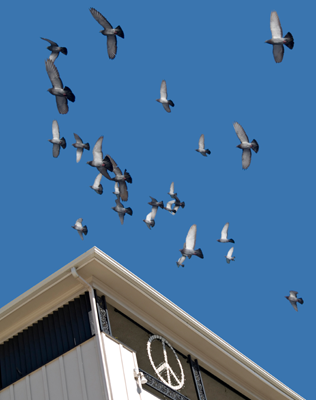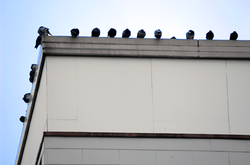 by Alex A. Kecskes
by Alex A. Kecskes
Pigeons are fun to feed, but when they gather in big numbers on your property, they cease being fun. And start being expensive. Specifically, they can take the paint or finish off wood and metal, crumble concrete and ruin expensive statues over time. Pigeon poop also poses a sizeable health risk. The fact is that pigeon droppings can carry and transmit any of 60 known diseases. And that's not even counting the diseases carried by the fleas, mites and ticks that attach themselves to pigeons. It's time for some serious pigeon control.
One solution that combines effectiveness with economy is the bird-scare product family. Here you'll find bright, colorful banners of foil that rattle and wave in the breeze. They're easily mounted to virtually any post, eave, mast or beam. Another pigeon control device, the Bird Scare Balloon, bobs and weaves in the breeze and uses the added tactic of large predator eyes to frighten pigeons.
Still another pigeon control solution is basically a catch-and-release device known as a Bird Motel. These humane live-trap cages are ideal for low populations of pest birds that gather on rooftops, courtyards and other areas. Made of sturdy galvanized wire, the cages can be used indoors or out. Your basic trap will have funnel doors that let birds in, but not out. Captured birds are easily removed via an access door. You can get these traps in various sizes to catch all manner of pest birds.
This next device uses a bird's aversion to unstable landing areas. Known as Bird Wire systems, these use a post-and-wire system to achieve pigeon control. Ideal for keeping pigeons off ledges, parapet walls, rooflines, handrails and similar troublesome areas, bird wire systems are humane, safe and economical. After a few tries, pigeons just give up and move on to a more stable perch. Bird wire systems have been approved for use on Federal and State government structures. Better systems use nylon coated stainless steel wire to withstand harsh weather.
We now come to the ubiquitous Bird Spike. These ingenious pigeon control devices are among the most successful and humane. Choose the plastic spike made of rigid U.V.-resistant unbreakable polycarbonate; or opt for the steel spike made of durable stainless steel. Both come in a variety of sizes to accommodate various bird types. Often recommended by architects, contractors and government agencies, the blunted spikes won't harm pigeons, just prevent them from landing. Also available are girder spikes, which are ideal for keeping pigeons from landing on girders or I-beams, and gutter bird spikes, to keep pigeons from landing and nesting in gutters.
One clever pigeon control device that's gaining in popularity is the Flat PVC Panel. Pigeons slip and slide off this deterrent like Keystone Cops on ice. No matter how they try, pigeons just can't land and they move on. Ideal for eaves, beams, ledges, and other 90-degree crevices where pigeons usually nest, the PVC panels are available in a number of neutral colors to match a building's aesthetics. Opt for U.V.-stabilized polycarbonate panels if you need them to last a long time.
To keep pigeons out of large areas, you might try Bird Netting. Ideal for preventing pigeons from gathering on rooftops, courtyards, patio covers, and other large areas, netting is also a popular pigeon control solution for growers and vintners who want to prevent pest birds from destroying their crops and grapes. The best netting is made of ISO 1806 mesh test polyethylene fabric, U.V. stabilized, flame resistant and rot and waterproof.
If you have a level flat or curved surface where people don't normally reach, you might try Electric Tracks. These efficient pigeon control devices have shown their worth in preventing pest birds from landing on ledges, rooflines, parapet walls, I-beams and signs. The electrified tracks deter pigeons by giving them a mild "zap." The low-profile electrified tracks install easily and can't be seen from below.
Pigeons also hate this next bird deterrent--Bird Gel. You squeeze it onto a flat surface and when it dries, it's still tacky to the touch. As a pigeon control product, it's non-toxic and harmless to birds, yet once pigeons get their footsies into it, it's bye-bye birdie and they'll never come back.
Certain sounds can really bug birds. Which is the principle behind Sonic Pigeon Control devices. These work quite well because they produce a variety of annoying distress and predator calls only pigeons can hear. One sonic system features the distress and predator calls of over 22 types of birds. The sounds are played every few minutes to alert birds of danger. Sonics are ideally suited for gardens, rooftops, courtyards, pool areas and other large open areas.
Finally, there's the Scarecrow. This unique motion-activated sprinkler delivers an annoying pulse of water whenever it senses a pigeon flying or walking near it. The water blast, the scarecrow's moving head and the sprinkler sound--all combine to scare pigeons away. Ideal for gardens, backyards, pools/spas and other areas.
3 Comments
by Terra Anders Pigeons, crows, grackles and blackbirds are all well known for their frequent gathering and roosting on rooftops, gutters, air conditioning vents and other structures. This problem affects private homes, public establishments and businesses. Pigeon control is important, not only because of the damage their feces causes to finishes and paint, but also because of the disease that the bacteria and small parasites in their feces may carry. Businesses may find that customers avoid their establishment if these birds are allowed to remain unchecked. These birds do deserve to set down and rest once in awhile, but having them settling in on your property means dealing with quite a mess. Controlling pest birds, like pigeons, does not have to be complicated or harmful to their health. There are several humane bird deterrent methods that can be used quite effectively to send these birds on their way. Any one of these methods can be used without the need for complex or expensive installation. Bird netting can be used when you want to keep birds away from flowers and crops, or from gaining access to any valuable structures. This type of netting is not used to trap the birds, but to keep birds out of a specific area. The most common use of netting is in orchards, vegetable gardens, and vineyards, but it can also be use indoors in larger structures where birds can fly in, and nest up high in the ceiling beams. Most netting is made with knotted strands of plastic cord, and is available in several thicknesses. Lightweight netting is often used indoors to stop bird pests from nesting inside large warehouses, hangers, or tunnels. Heavy-duty bird net is used outdoors, and is designed to resist deterioration in sunlight, rain and extreme heat. It is also available in different widths and lengths. Specially designed plastic clips can be used to attach the netting, preventing damage to the surface being protected. Pigeons, or other bird pests, look for a landing surface that is flat and even. Bird spikes is a method commonly used to deter these birds from roosting on their favorite flat surfaces, such as roofs, ledges, gutters, or signs. These spikes are available in steel or plastic and in many colors, so once installed they are virtually invisible. The spikes are not sharp enough to cause harm, but they are severe enough to create an uncomfortable landing place for winged pests, forcing them to fly onward to find a more suitable area. Another bird control method is an electric bird deterrent system. This system uses a polycarbonate insulator wire embedded in an insulted PVC track that conforms to straight or curved surfaces. They are most effective when laid down over a large, flat area that is likely to invite pigeons or other pest birds to roost. As the bird lands on the unassuming strip, it will receive a light warning shock, causing it to immediately fly away. The shock is not harmful, but it is uncomfortable enough that the pest birds will quickly learn that this is not a suitable landing or nesting spot. This method employs a behavior modification technique that does not interfere with the birds flying patterns, but does change their landing patterns. Controlling pigeon flocks and other feathered friends from becoming damaging pests, is one way to continue to enjoy watching their fanciful flights without the worry of the mess they leave behind. Bird netting, bird spikes and electric bird deterrent systems are all effective and humane choices to consider when deciding which pigeon control methods to use.  by Fran Prisco
Pigeons that are a pest in our cities and suburbs across the Nation are ancestors of the Rock Dove. Rock Doves built their nests high on rock cliffs, very similar to our city buildings of today. Pigeon nests are made up of loose twigs and other material that is found nearby. Along with nesting material, pigeons also leave behind a mess with their droppings and molted feathers. Each year building owners spend thousands to get rid of pigeons from their buildings. Clean up First Before installing any type of bird control system, it is important to do a thorough cleanup. It is best to power wash or spray bird droppings down and remove them while wet. Dried bird droppings can cause dust which when breathed in may carry any of 60 plus communicable diseases. Bird Droppings are also acidic and can quickly erode building and roofing materials, not to mention that they are a safety hazard on sidewalks, causing slip and fall accidents. |

 RSS Feed
RSS Feed